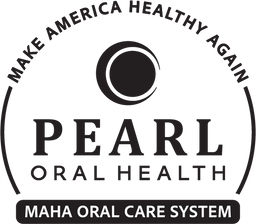Dentistry has been trying, for years, to figure out why some people get rampant decay and others pay no attention to their oral care or diet, and rarely, if ever experience dental decay. So what really causes tooth decay?
Turns out there are miles of dentinal tubules inside your teeth connected to the vital pulp. It is a hydraulic-pump system. The function of this DFTS is both extremely complex and vital to proper tooth vitality and remineralization.
The Dentinal Fluid Transport System (DFTS)
There are miles of microscopic micro-tubular super highways in each one of your teeth called odontoblastic dentinal tubules. These odontoblastic tubules comprise the dentinal fluid transport system (DFTS), which is responsible for carrying enzymes, minerals, amino acids and many more critical substances into and out of your teeth. The way this system operates depends on some very key components and concepts.
Let’s take a closer look.

The above picture is a microscopic photo of the DFTS’s tubular nature. The photo below shows the positioning of the tubules. These channels are responsible for nourishing your teeth. They also contribute to the sensitivity after a tooth has had a filling or crown procedure. The closer to the pulp you get, the more tubules there are, and the bigger in diameter they become.

So What Really Causes Tooth Decay?
This is a highly valuable, necessary, and overlooked system that plays a HUGE ROLE in how your teeth and body function, and whether or not they stay healthy or get decay! Can you say, “remineralization vs. demineralization”.
Two researchers have done a tremendous amount of great work on the DFTS, which to this day remains largely ignored. Surprise, surprise. I have written this article in their honor and to awaken the dental and medical world to its importance.
Understanding the DFTS and What Causes Tooth Decay
1. Dentin is living tissue, composed of cells called odontoblasts, dependent on a transport system which is bi-directional, and has no vascular blood supply.
2. Dentin is designed for fluid transport from the pulp to the enamel interface. The enamel is also porous, thus facilitating fluid flow to the outside of the tooth.
3. The DFTS is driven by a hypothalamic-parotid endocrine hormonal exchange.
4. A hydrostatic pressure gradient exists in the system and favors the flow of nutrients from inside of the pulp chamber to the enamel surface on the outside of the tooth.
5. This is a pump-system, with the fluid in the pulp chamber being derived from the blood. The composition of the fluid being pumped through the tubular system is composed of blood, minus the large protein molecules. It’s called DENTAL LYMPH FLUID, and it contains essential nutrients for maintaining the vitality of the dentin.
6. The essential nutrients in the DENTAL LYMPH FLUID consists of: glucose for metabolism, amino acids for synthesizing dentinal collagen, and minerals to mineralize dentinal collagen.
7. This whole system is dependent on proper pH. You must maintain consistent acid levels above 5.5. This is why alkaline diets along with alkaline oral health products are so important.
8. This transport system is also dependent on a hormone from the parotid gland called: PAROTID HORMONE. It is signaled by the Pituitary gland.

9. In healthy teeth, the fluid flow direction is outward toward the enamel surface from the pulpal chamber which is inside the tooth.
Healthy Teeth Have Outward Dental Lymph Fluid Flow!
10. The hydrostatic pressure within the teeth is higher than in the mouth, and this differential causes the odontoblastic cells to pump fluid from inside the pulp to the enamel surface.
Dental Lymph Fluid Flow is Reversed in Unhealthy Teeth!
This is a major league big deal! Why? Because oral fluids can now gain entrance into the dentin through the enamel and cause CARIOGENESIS. Can you say tooth decay?
Let's Summarize How All These Factor's Work Together
THE PAROTID GLAND - This is the major salivary gland on the inside of your cheeks that is responsible for salivary production and the relay signaling from the Hypothalamus.
THE PAROTID HORMONE - This hormone appears to alter the permeability of the odontoblastic cell membrane allowing for the unwanted inward flow of DENTAL LYMPH FLUID into the ODONTOBLASTS. These are the cells that make dentin, sometimes called dentine. Parotid Hormone enters the circulation and activates the DFTS present in the odontoblasts.
This is key. This dentinal fluid has a great ability to buffer the pH of the fluid at 7.4, and to keep this fluid pH at the same level as the blood.
THE ACIDOGENIC EFFECT OF HIGH-SUGAR DIETS ON THE DFTS - When the intra-oral environment is acidic, due to highly-processed sugary diets, it reverses the flow of the DFTS. Sugar suppresses the function of the HPEA, leading to a decrease in PH secretion.
THE HYPOTHALAMIC-FACTOR in THE DENTAL CARIES RELATIONSHIP - A reversal of Dentinal Lymph Fluid (DLF) in the tooth allows for the penetration of acids and other hostile substances to enter the tooth structure leading to demineralization. This is bad news!

THE SUCROSE EFFECT - High sucrose diets inhibit the production and flow of saliva, and have been shown to cause atrophy of the parotid glands. This also decreases the alkaline environment, thus favoring tooth decay.
DFTS ACTIVITY AND THE INCIDENCE OF CARIES - What really causes tooth decay? The more the fluidity in the system is reversed or slowed down, the more the decay flourishes.
THE HYPOTHALAMIC-PAROTID GLAND ENDOCRINE AXIS (HPEA) - The master gland in your brain responsible for the signaling and relay to the parotid gland to produce Parotid Hormone, called the Hypothalamic-Parotid Exocrine Axis (HPEA).
THE EFFECT OF ENDOGENOUS COMPOUNDS - Certain compounds like carbamoyl aspartate and carbamoyl phosphate, have a very positive effect on caries inhibition, by 89%.
Source: Ralph Steinman and John Leonora; Dentinal Fluid Transport; 2004, Loma Linda Publishing
Find a mercury-free dentist in your area here.
Life Rejuvenation Systems | All Rights Reserved | www.DrLokensgard.com


